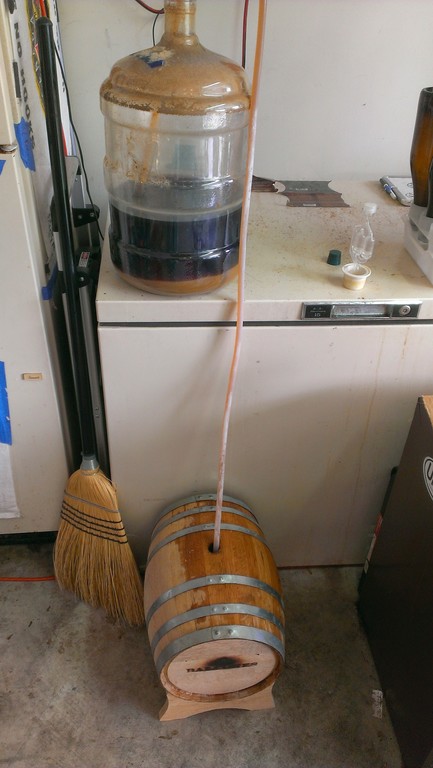
2 liter starter of Wyeast 2001 Urquell lager yeast.
I’ve not brewed many lager recipes. In fact, just one. I did a clone of Spaten Optimator. It actually came out quite good. Scored well in homebrew competitions, better than my Pales and IPAs much to my chagrin. Most of the results came from following the advice in the New Brewering Lager Beer by Greg Noonan
That said, I’ve had a few surprises in a category of beers that I tend not to drink, let alone brew. Pilsners. When I read the description of the style and most beers, I’m excited. After tasting them, not nearly as excited as I was before doing so. For me, the signature “flavor” of lagers tend to come from the yeast itself, which is described as “clean” however, I pick up a distinct flavor that just isn’t may favorite.
I’ve been surprised by a number of pilsners which exhibit none of the lagery yeast flavors and all of the good things I read in the style description: crispness, dry finish, clean flavors, noble hoppy aroma. My first real surprise pilsner was actually Urquell. It was a real surprise to me. Bright, crisp, clean, hoppy even. Next, on a whim, I picked up Sam Adam’s Noble Pils. While a far cry from a typical pilsner, it had all of the same characteristics I enjoyed. Finally, a local favorite, Austin Beerworks Pearl Snap Pils.
With that background, I searched around for a clone and ended up finding the Sam Adams Noble Pils from the August 2011 Issue of Zymurgy. I’ll pulled that and will adapt it a bit. Surprisingly, the Sam Adams recipe calls from mostly 2-row with a little pilsner. Instead, I inverted it, mostly pilsner and a little 2-row; local Blacklands Pale Moon malt.
Enjoy!
Recipe Details
| Batch Size |
Boil Time |
IBU |
SRM |
Est. OG |
Est. FG |
ABV |
| 5 gal |
90 min |
42.4 IBUs |
3.8 SRM |
1.053 |
1.014 |
5.1 % |
|
Actuals |
1.046 |
1.01 |
4.7 % |
Style Details
| Name |
Cat. |
OG Range |
FG Range |
IBU |
SRM |
Carb |
ABV |
| German Pilsner (Pils) |
2 A |
1.044 - 1.05 |
1.008 - 1.013 |
25 - 45 |
2 - 5 |
2.4 - 2.8 |
4.4 - 5.2 % |
Fermentables
| Name |
Amount |
% |
| Pilsner (2 Row) Ger |
7.2 lbs |
73.1 |
| Brewers Malt 2-Row (Briess) Organic |
2.4 lbs |
24.37 |
| Acidulated (Weyermann) |
4 oz |
2.54 |
Hops
| Name |
Amount |
Time |
Use |
Form |
Alpha % |
| Liberty |
2 oz |
60 min |
Boil |
Pellet |
3.9 |
| Saaz |
0.49 oz |
5 min |
Boil |
Pellet |
7.6 |
| Tettnang |
0.25 oz |
5 min |
Boil |
Pellet |
4.6 |
| Tettnang |
0.81 oz |
7 days |
Dry Hop |
Pellet |
4.6 |
| Saaz |
0.6 oz |
7 days |
Dry Hop |
Pellet |
7.6 |
| Select Spalt |
0.39 oz |
7 days |
Dry Hop |
Pellet |
4.9 |
| Crystal |
0.21 oz |
7 days |
Dry Hop |
Pellet |
3 |
Miscs
| Name |
Amount |
Time |
Use |
Type |
| Gypsum (Calcium Sulfate) |
2.30 g |
60 min |
Mash |
Water Agent |
| Calcium Chloride |
1.10 g |
60 min |
Mash |
Water Agent |
| Epsom Salt (MgSO4) |
0.40 g |
60 min |
Mash |
Water Agent |
| Whirlfloc Tablet |
1.00 Items |
15 min |
Boil |
Fining |
| Yeast Nutrient |
1.00 tsp |
3 days |
Primary |
Other |
Yeast
| Name |
Lab |
Attenuation |
Temperature |
| Urquell Lager (2001) |
Wyeast Labs |
74% |
48°F - 58°F |
Mash
| Step |
Temperature |
Time |
| Protein Rest |
122°F |
10 min |
| Saccharification |
154°F |
45 min |
| Mash Out |
168°F |
10 min |


